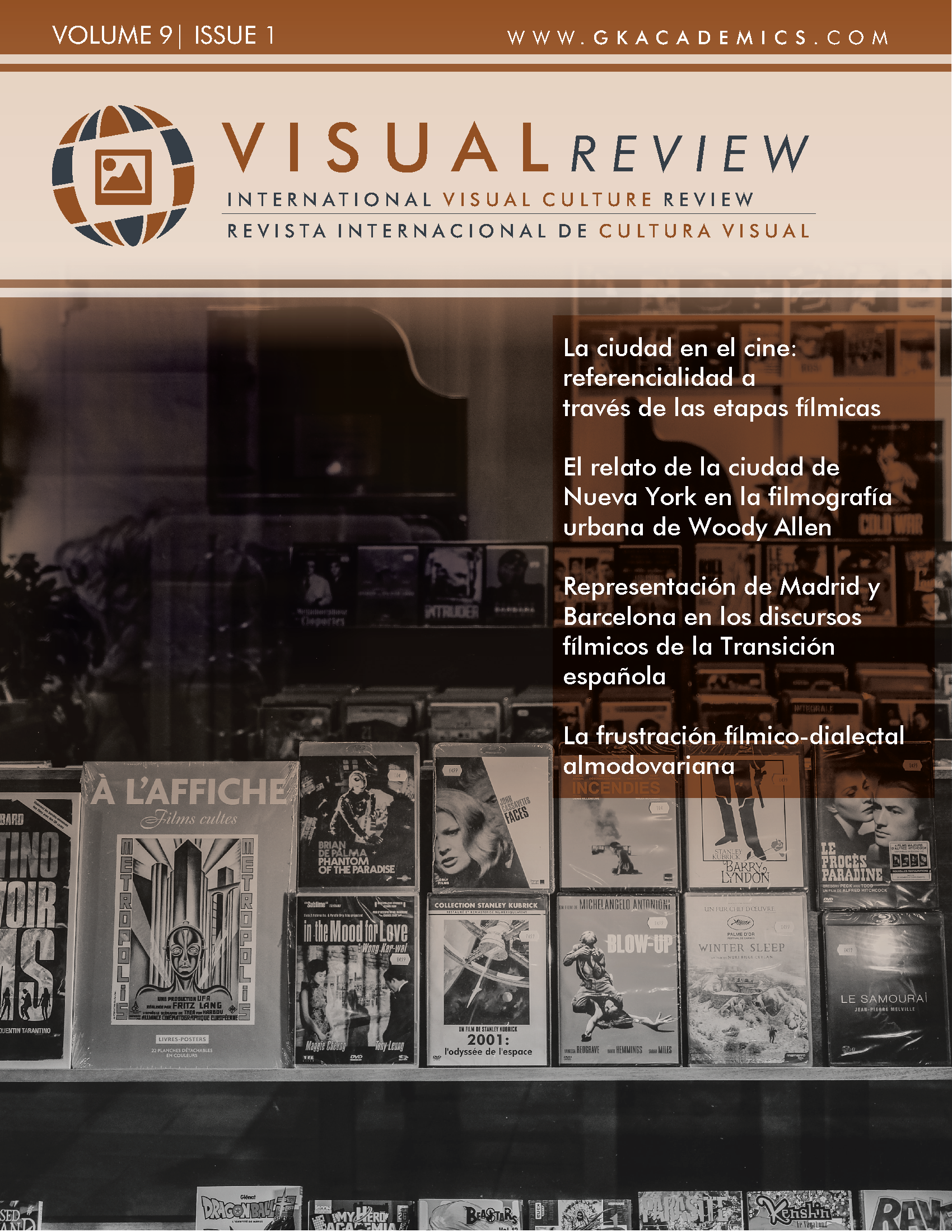The New York City tale in the urban filmography of Woody Allen
DOI:
https://doi.org/10.37467/gkarevvisual.v9.3072Keywords:
Cinema, city, New York City, Woody Allen, urban tale, cinematographic analysisAbstract
Woody Allen is one of the directors who have worked the most the city on his filmography. New York City is an icon that defines his work. In order to know what the image he has projected of New York is, his urban work has been analyzed in a transversal way. The process consisted of breaking down the feature films into sequences and selecting those fragments of New York urban content. These sequences were analyzed from various perspectives: visual, oral, and narrative. The interpretation of the results leads to the conception of a coherent New York urban identity tale that goes through different stages in the director's filmography.
Downloads
Global Statistics ℹ️
|
470
Views
|
259
Downloads
|
|
729
Total
|
|
References
Allen, W. (Dirección). (1977). Annie Hall [Película]. United Artists.
Allen, W. (Dirección). (1979). Manhattan [Película]. United Artists.
Allen, W. (Dirección). (1984). Broadway Danny Rose [Película]. Orion Pictures.
Allen, W. (Dirección). (1986). Hannah y sus hermanas [Película]. Orion Pictures Corporation, Jack Rollins & Charles H. Joffe Productions.
Allen, W. (Dirección). (1987). Días de radio [Película]. Orion Pictures.
Allen, W. (Dirección). (1989). Delitos y faltas [Película]. Orion Pictures.
Allen, W. (Dirección). (1993). Misterioso asesinato en Manhattan [Película]. TriStar Pictures.
Allen, W. (Dirección). (1994). Balas sobre Broadway [Película]. Miramax,
Allen, W. (Dirección). (1996). Todos dicen I Love You [Película]. Miramax, Jean Doumanian Productions.
Allen, W. (Dirección). (2002). Un final Made in Hollywood [Película]. DreamWorks Pictures, The Kennedy/Marshall Company.
Allen, W. (Dirección). (2003). Todo lo demás [Película]. DreamWorks Pictures.
Allen, W. (Dirección). (2008). Vicky Cristina Barcelona [Película]. Mediapro, Wild Bunch, The Weinstein Company.
Allen, W. (Dirección). (2009). Si la cosa funciona [Película]. Gravier Productions, Perdido Productions, Wild Bunch.
Allen, W. (Dirección). (2013). Blue Jasmine [Película]. Gravier Productions, Perdido Productions.
Allen, W. (Dirección). (2016). Café Society [Película]. Gravier Productions, Perdido Productions.
Allen, W. (Dirección). (2017). Wonder Wheel [Película]. Amazon Studios.
Antoniazzi, S. (2019). La ciudad filmada: cine, espacio e historia urbana. Biblio3W Revista Bibliográfica de Geografía y Ciencias Sociales, 24(160), 1-29. DOI: https://doi.org/10.1344/b3w.0.2019.27278
Ascher, F. (2004). Los nuevos principios del urbanismo. Alianza.
Aumont, J. y Marie, M. (1990). Análisis del film. Ediciones Paidós Ibérica.
Chatman, S. (2013). Historia y discurso: la estructura narrativa en la novela y en el cine. RBA.
De Miguel Zamora, M. (2016). La trilogía urbana de Woody Allen. Cómo conocer Nueva York a través del cine. Bifurcaciones, 21. https://bit.ly/3jv02Qq
Fernández Díez, F. y Martínez Abadía, J. (2003). Manual básico de lenguaje y narrativa audiovisual. Paidós Ibérica.
Fonte, J. (2012). Woody Allen. Ediciones Cátedra.
Giménez, G. (2010). Memoria, relatos e identidades urbanas. Versión: estudios de comunicación y política, 23, 197-209. https://bit.ly/3gDMBvG
Gómez-Tarín, F. J. y Marzal Felici, J. (2007). Una propuesta metodológica para el análisis del texto fílmico. Metodologías de análisis del film. Actas del I Congreso Internacional sobre Análisis Fílmico. Edipo.
Lax, E. (1994). Woody Allen. Ediciones B.
Llorca, J. (2018). El cine como documento de investigación y evidencia de la modernidad urbana. Estado de la cuestión y una propuesta. Dearq, 24, 182-190. https://doi.org/10.18389/dearq24.2019.10 DOI: https://doi.org/10.18389/dearq24.2019.10
López Hernández, Á. (2003). El análisis cronológico-secuencial del documento fílmico. Documentación de las Ciencias de la Información, 25, 261-294. https://bit.ly/3Irc3QA
Martín, C. (28 de abril de 2018). Los Hamptons, el rincón dorado de los neoyorquinos. El Mundo (Edición Digital). https://bit.ly/32noPQC
Martínez García, M. Á. (2012). Laberintos narrativos: estudio sobre el espacio cinematográfico. Gedisa.
Real Academia Española. (s.f). Ciudad. En Diccionario de la lengua española. https://bit.ly/3qSYqnp
Simmel, G. (2011). El individuo y la libertad. Ensayos de crítica de la cultura. Las grandes urbes y la vida del espíritu. Revista de estudios sociales, 10, 107-109. https://bit.ly/2V7v4o2 DOI: https://doi.org/10.7440/res10.2001.12
Sulbarán Piñeiro, E. (2000). El análisis del film: entre la semiótica del relato y la narrativa fílmica. Opción: Revista de Ciencias Humanas y Sociales, 31, 44-71. https://bit.ly/3FTN5HK
The Official Website of the City of New York (2021). The Official Website of the City of New York: https://www1.nyc.gov
Tovar-Vicente, M. (2014). Midnight in Paris (Woody Allen, 2011): la omisión del pasado como constituyente de la identidad urbana presente. Arte y Ciudad - Revista de Investigación, 7-40. https://bit.ly/3GPXoxU
Valera, S. y Pol, E. (1994). El concepto de identidad social urbana: una aproximación entre la Psicología Social y la Psicología Ambiental. Anuario de Psicología, 5-24. https://raco.cat/index.php/AnuarioPsicologia/article/view/61126/88865
Vanoye, F. y Goliot-Lété, A. (2008). Principios del análisis cinematográfico. Adaba Editores.
Villafañe, J. y Mínguez, N. (2006). Principios de teoría general de la imagen. Ediciones Pirámide.
World Population Review (2021). World Population Review: https://worldpopulationreview.com
Downloads
Published
How to Cite
Issue
Section
License
Those authors who publish in this journal accept the following terms:
-
Authors retain copyright.
-
Authors transfer to the journal the right of first publication. The journal also owns the publishing rights.
-
All published contents are governed by an Attribution-NoDerivatives 4.0 International License.
Access the informative version and legal text of the license. By virtue of this, third parties are allowed to use what is published as long as they mention the authorship of the work and the first publication in this journal. If you transform the material, you may not distribute the modified work. -
Authors may make other independent and additional contractual arrangements for non-exclusive distribution of the version of the article published in this journal (e.g., inclusion in an institutional repository or publication in a book) as long as they clearly indicate that the work was first published in this journal.
- Authors are allowed and recommended to publish their work on the Internet (for example on institutional and personal websites), following the publication of, and referencing the journal, as this could lead to constructive exchanges and a more extensive and quick circulation of published works (see The Effect of Open Access).













